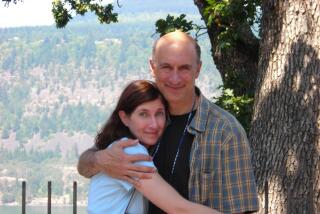Choosing against life
A Sorrow Beyond Dreams
Peter Handke
Translated from the German by Ralph Manheim
New York Review Books: 80 pp., $10.95 paper
*
The Angel and the Dragon
A Father’s Search for Answers
to his Son’s Mental Illness and Suicide
Jonathan Aurthur
Health Communications: 362 pp., $12.95 paper
*
Judging whether life is worth living or not is, as Camus famously wrote, the fundamental question of philosophy. Yet he clearly understates the problem. For those who kill themselves, there can be no second-guessing. That decision is merely the surcease of pain. Hardly an answer, it is the beginning of the anger, the sorrow, the guilt, disbelief and shame for those left behind. But the real legacy of suicide is a story, a reiteration of Camus’ question tied onto every memory and every memory recast, reshaped and re-imagined to provide an explanation for an event that has none. Perhaps no two authors could be more dissimilar in their ventures into this territory than Peter Handke and Jonathan Aurthur, and it is precisely their differences that make their stories important today.
“A Sorrow Beyond Dreams,” written in 1972 and first published by Farrar, Straus & Giroux in 1975, is Handke’s account of his mother’s life and death. Prosaic, poetic, elliptical and self-conscious, it is an exacting picture of the shock and grief that await those who have inherited the ruins of a suicide. “The Angel and the Dragon” is messier and more desperate. The story of Charley Aurthur’s life and his death in 1996, told by his father, lacks literary concision but gains momentum in its inconsolable grappling with the meaning of mental illness.
Charley Aurthur was by all accounts a talented and precocious child. He was born in 1973 of activist (and soon to be divorced) parents, grew up in Culver City, played the piano with obvious aptitude and wrote. By the time he turned 15, however, a shadow, tinged by insomnia and abrupt mood swings, had begun to dim his talent. Then, the summer between his freshman and sophomore years at college, he took a weekend trip to Yosemite and, while driving home, totaled the family car. A week later, he was sitting with his parents and a psychiatrist, who recommended that he be hospitalized. It is every parent’s nightmare: Aurthur and his ex-wife soon learned that the accident and Charley’s subsequent behavior -- jittery, dazed, anxious and weeping -- were most easily understood as the symptoms of a psychotic break.
The Aurthurs’ introduction to the world of mental illness was precipitous. For his part, Charley experienced disorienting extremes of delusion and despair, reconstructed here through his letters, poetry and journal entries. His doctors debated whether he suffered from manic depression or schizophrenia. (Their diagnoses were often guided by the effectiveness of specific medications, which after one suicide attempt became an extraordinary cocktail of Navane, Cogentin, Klonopin, lithium and Wellbutrin, cut by an occasional session of psychotherapy.) Aurthur was no better prepared emotionally -- or financially -- than Charley and found himself searching the past and the present for a clue as to why his once seemingly balanced child had changed and what could be done to set his life right again. He ranged broadly through the written landscape -- from Michel Foucault to A. Alvarez, from Kay Redfield Jamison to Kate Millett -- scrutinizing biomedical and psychosocial treatments and fast confronting his own powerlessness in the face of Charley’s rapid decline.
Mental illness is a phrase you won’t find in Handke’s account of his mother’s death, yet it surely waits in the wings. While attempting a factual account of his mother’s life, told with a journalist’s precision (“The Sunday edition of the Karntner Volkszeitung,” his story begins, “carried the following item under ‘Local News’: ‘In the village of A. (G. township), a housewife, aged 51, committed suicide on Friday night ....’ ”), Handke can’t help but fall through the occasional trapdoor. “This story,” he concedes, “
Born in a small Austrian village in the 1920s, Handke’s mother -- he keeps her nameless -- lived in a world constrained by history and convention, where girls grew up playing a game based on the stations of a woman’s life, Tired/Exhausted/Sick/Dying/Dead, where Hitler was a man with “a nice voice” and World War II became “contact with a fabulous world.” Pregnant by her first love -- a married man who disappeared from her life as quickly as he appeared -- she married a German army sergeant, and, after the war, they settled in Berlin, where he worked as a streetcar motorman and drank, worked as a baker and drank, and finally just drank. She had a second child, aborted a third and grew old before her time. In 1948, they fled the eastern sector of the city and returned to Austria, to the house where she was born and where life bore only a marginal resemblance to middle-class privilege. “Squalid misery can be described in concrete terms,” Handke writes; “poverty can only be intimated in symbols.” And poverty abounded.
Given the fact of her death, the mystery is how she survived these years, but it is not uncommon to find purpose in great hardship. She swaddled herself with the illusion of progress, the chimera of change, and, in truth, her husband, now in middle age, was becoming less of a bully, and she -- we are told rather cryptically -- “was gradually becoming an individual.”
But suicide is not the result of one moment or one wound. It is a slow accumulation of pain, often triggered by a physical malady. She began having bad headaches. Her doctor thought it was a strangulated nerve, and what first incapacitated her (“She dropped everything she picked up, and would gladly have followed it in its fall. Doors got in her way; the mold seemed to rain from the walls as she passed
The final pages of Handke’s story are a wrenching litany of real and imagined moments, of syncopated flights of mostly single-sentence paragraphs -- heart-wrenching associations and chasms of silence between each thought -- and when he recounts the flight home for the funeral, he confesses: “I was beside myself with pride that she had committed suicide,” as if she had finally availed herself of the only freedom remaining to her. It is a stunning line. Could Jonathan Aurthur make this claim? Perhaps. Eleven days after Charley leaped from Lincoln Boulevard into the morning rush hour on the Santa Monica Freeway, Aurthur visited the overpass, stared into the flow of traffic and walked away feeling suddenly, perhaps inexplicably, liberated. “[Charley’s] terrible affliction and suffering had imprisoned him but it had also imprisoned me,” he writes, “and now both of us were free.”
During his last three years, Charley had been buffeted among five hospitals, a process that Aurthur equates with the life of a soldier “repeatedly wounded, repeatedly sprayed with sulfa drugs and patched up and sent back to the trenches, a little weaker each time.” At the end of each treatment, Aurthur was left with no greater certainty about what could be done to restore his son, and, indeed in some cases, questioned whether the cure might be worse than the disease.
Thirty years may be an instant and an eternity when comparing the world between “A Sorrow Beyond Dreams” and “The Angel and the Dragon,” but the before and after of a suicide has changed little. The statistics are stark. In this country today, a person completes a suicide every 15 minutes, and almost as often someone is left behind to try to make sense of it. It may be a father remembering his son; it may be a son remembering his mother. In either case, it is less a philosophical question than a profoundly social problem.
While the pleasure, if this is the word, of reading Handke comes from the existential assumptions of his story, it is important to realize that suicide -- the reality, as opposed to the idea (which Camus seemed to savor) -- is not an existential dilemma. It is the final, tragic outcome of a psychiatric illness. Yet how prepared are we for this knowledge?
There is no more a prescribed course for treating mental illness than there is a prescribed course for being human, and as Aurthur looks at what we now know -- and don’t know -- about mental illness, it becomes clear that the model we have today for understanding the diseases of the mind and suicide is inadequate. Beyond the brain-mind dichotomy that has of late polarized our understanding of human behavior must lie a paradigm that will break the icy rivers of vested interests, professional bias and brazen certainty and encompass the complex social and emotional roots of these diseases. Certainly, Handke’s and Aurthur’s books suggest this need.
More to Read
Sign up for our Book Club newsletter
Get the latest news, events and more from the Los Angeles Times Book Club, and help us get L.A. reading and talking.
You may occasionally receive promotional content from the Los Angeles Times.







